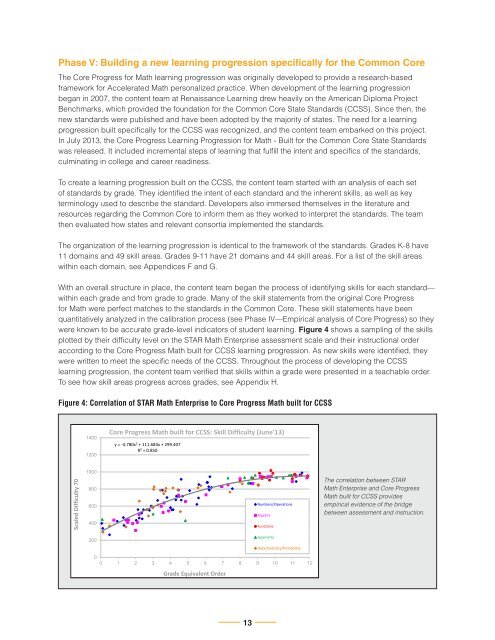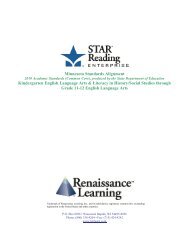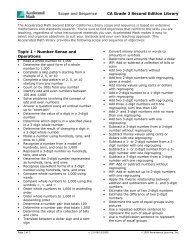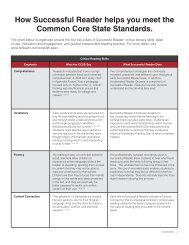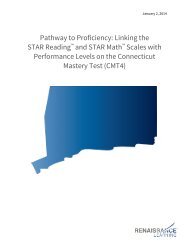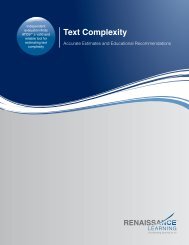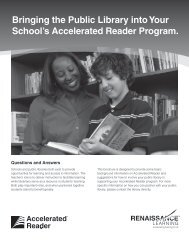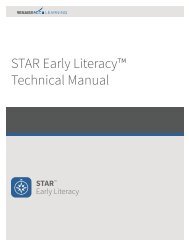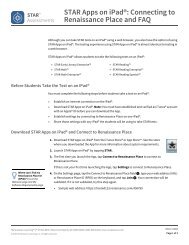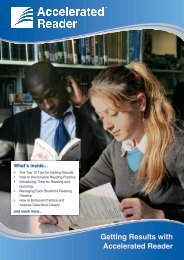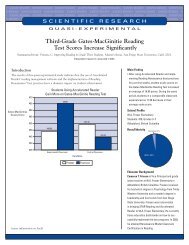Core Progress⢠for Math - Renaissance Learning
Core Progress⢠for Math - Renaissance Learning
Core Progress⢠for Math - Renaissance Learning
Create successful ePaper yourself
Turn your PDF publications into a flip-book with our unique Google optimized e-Paper software.
Phase V: Building a new learning progression specifically <strong>for</strong> the Common <strong>Core</strong>The <strong>Core</strong> Progress <strong>for</strong> <strong>Math</strong> learning progression was originally developed to provide a research-basedframework <strong>for</strong> Accelerated <strong>Math</strong> personalized practice. When development of the learning progressionbegan in 2007, the content team at <strong>Renaissance</strong> <strong>Learning</strong> drew heavily on the American Diploma ProjectBenchmarks, which provided the foundation <strong>for</strong> the Common <strong>Core</strong> State Standards (CCSS). Since then, thenew standards were published and have been adopted by the majority of states. The need <strong>for</strong> a learningprogression built specifically <strong>for</strong> the CCSS was recognized, and the content team embarked on this project.In July 2013, the <strong>Core</strong> Progress <strong>Learning</strong> Progression <strong>for</strong> <strong>Math</strong> - Built <strong>for</strong> the Common <strong>Core</strong> State Standardswas released. It included incremental steps of learning that fulfill the intent and specifics of the standards,culminating in college and career readiness.To create a learning progression built on the CCSS, the content team started with an analysis of each setof standards by grade. They identified the intent of each standard and the inherent skills, as well as keyterminology used to describe the standard. Developers also immersed themselves in the literature andresources regarding the Common <strong>Core</strong> to in<strong>for</strong>m them as they worked to interpret the standards. The teamthen evaluated how states and relevant consortia implemented the standards.The organization of the learning progression is identical to the framework of the standards. Grades K-8 have11 domains and 49 skill areas. Grades 9-11 have 21 domains and 44 skill areas. For a list of the skill areaswithin each domain, see Appendices F and G.With an overall structure in place, the content team began the process of identifying skills <strong>for</strong> each standard—within each grade and from grade to grade. Many of the skill statements from the original <strong>Core</strong> Progress<strong>for</strong> <strong>Math</strong> were perfect matches to the standards in the Common <strong>Core</strong>. These skill statements have beenquantitatively analyzed in the calibration process (see Phase IV—Empirical analysis of <strong>Core</strong> Progress) so theywere known to be accurate grade-level indicators of student learning. Figure 4 shows a sampling of the skillsplotted by their difficulty level on the STAR <strong>Math</strong> Enterprise assessment scale and their instructional orderaccording to the <strong>Core</strong> Progress <strong>Math</strong> built <strong>for</strong> CCSS learning progression. As new skills were identified, theywere written to meet the specific needs of the CCSS. Throughout the process of developing the CCSSlearning progression, the content team verified that skills within a grade were presented in a teachable order.To see how skill areas progress across grades, see Appendix H.Figure 4: Correlation of STAR <strong>Math</strong> Enterprise to <strong>Core</strong> Progress <strong>Math</strong> built <strong>for</strong> CCSS14001200<strong>Core</strong> Progress <strong>Math</strong> built <strong>for</strong> CCSS: Skill Difficulty (June'13)y = -4.780x 2 + 111.684x + 299.407R² = 0.850Scaled Difficulty 701000800600400Numbers/OperationsAlgebraFunctionsThe correlation between STAR<strong>Math</strong> Enterprise and <strong>Core</strong> Progress<strong>Math</strong> built <strong>for</strong> CCSS providesempirical evidence of the bridgebetween assessment and instruction.Geometry200Data/Statistics/Probability00 1 2 3 4 5 6 7 8 9 10 11 12Grade Equivalent Order13


